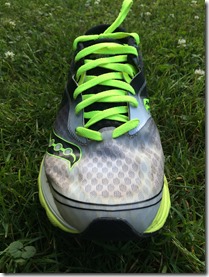 The Saucony Kinvara has long been a top option for me among low-drop, lightweight training shoes. I’ve run marathons in the Kinvara, and have had positive experiences with most iterations of the shoe that have come out. Since the arrival of the Kinvara 7 a few months ago, I’ve heard a lot of mixed opinions about the newest version of the shoe . Some have suggested that it’s lost some of it’s magic by becoming a more traditional-style shoe, whereas my friend Thomas over at Believe in the Run says it feels pretty similar to v6.
The Saucony Kinvara has long been a top option for me among low-drop, lightweight training shoes. I’ve run marathons in the Kinvara, and have had positive experiences with most iterations of the shoe that have come out. Since the arrival of the Kinvara 7 a few months ago, I’ve heard a lot of mixed opinions about the newest version of the shoe . Some have suggested that it’s lost some of it’s magic by becoming a more traditional-style shoe, whereas my friend Thomas over at Believe in the Run says it feels pretty similar to v6.
I tend to agree with Thomas here – though both the upper and sole have been changed in v7, the shoe retains the essence of what the Kinvara is. It’s still a lightweight (sub 8oz in size 9), affordable ($110 MSRP), 4mm drop shoe (22mm heel, 18mm forefoot) that is suitable for both speed and longer distances (specs via Running Warehouse). As someone who prefers less shoe underfoot, the Kinvara is more of a distance trainer and marathon racer for me, and v7 still fits that bill quite nicely.
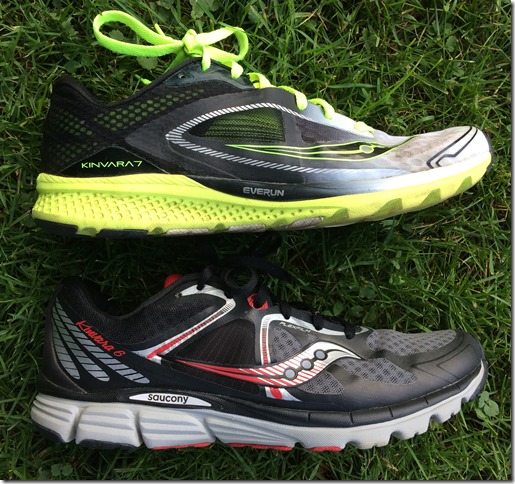 Saucony Kinvara 7 (top) vs. Kinvara 6 (bottom)
Saucony Kinvara 7 (top) vs. Kinvara 6 (bottom)
Upper
The upper of the Kinvara 7 is really pretty similar to that of the previous version. The mesh has changed slightly, overlays have been moved around, and the Saucony logo has been shifted forward toward the forefoot (similar to what Brooks has done on some of their shoes). But in terms of fit, function, and comfort, there really isn’t much noticeable change. In most ways, it’s still a fairly simple, minimally structured upper (for example, the heel counter remains very soft and flexible). Saucony did opt to keep the Pro-Lock wrap around the midfoot – I honestly don’t have a preference one way or the other about it, but my general feeling is that it doesn’t do much (similar to the Brooks PureProject NavBand), and could therefore be eliminated to shave a bit of weight and simplify the shoe.
 Saucony Kinvara 7 (top) vs. Kinvara 6 (bottom)
Saucony Kinvara 7 (top) vs. Kinvara 6 (bottom)
Fit
Perhaps the biggest difference I noticed in the Kinvara 7 is the fit (note: I always go 1/2 size up in the Kinvara). K6 fit me well, but the forefoot of K7 feels downright spacious to me. It may be the roomiest forefoot I have felt in any version of the Kinvara. Midfoot and heel lock down well, and this is one of the better-fitting shoes I have tried in awhile – would be a great option for swelling associated with longer distances for my feet (I’ve probably run over 70 miles in them, but long runs maxed out a 7-8 miles).
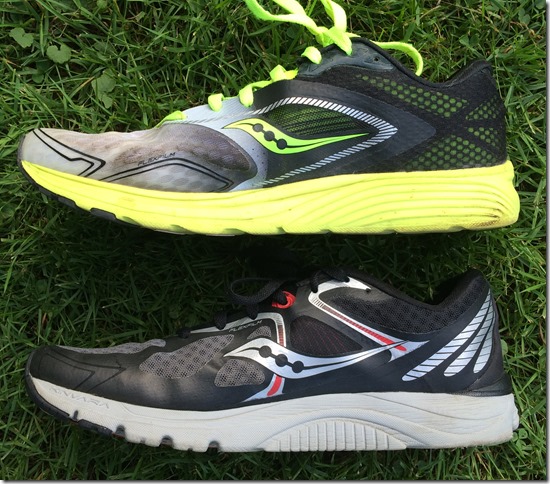 Saucony Kinvara 7 (top) vs. Kinvara 6 (bottom)
Saucony Kinvara 7 (top) vs. Kinvara 6 (bottom)
Midsole
The big thing that Saucony is touting about the Kinvara 7 is the addition of a wedge of Everun cushioning in the midsole under the heel. From what I gather, Everun is similar to the adidas Boost compound – Saucony claims increased energy return, and better resistance to breakdown over time. To be honest, I couldn’t feel the stuff at all. I tend toward a mild heel strike with most loading under the midfoot, so my stride isn’t always the best to assess heel cushion. If anything, and this may be my biggest complaint about the Kinvara 7, the sole felt a bit dead to me. The Kinvara 7 does not feel springy like the adidas Adios Boost, moreso like the RevLite material used in some New Balance shoes. And it doesn’t feel quite as soft as previous versions of the Kinvara – I’m liking the ride of the New Balance Zante 2 better right now for longer distances for this reason. I’d be curious to try a shoe with a sole made entirely of Everun – as it is now, you likely won’t notice much unless you really pound the heel.
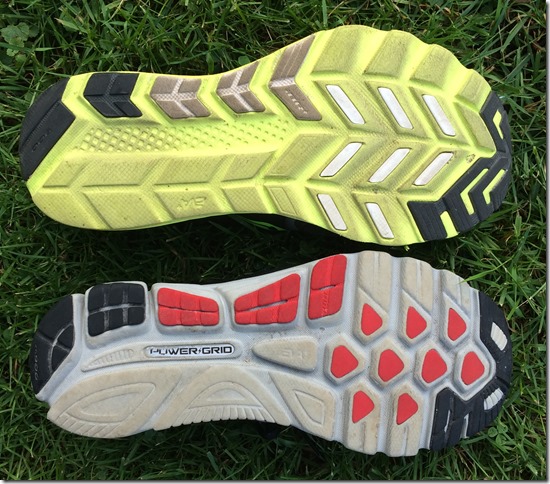 Saucony Kinvara 7 (top) vs. Kinvara 6 (bottom)
Saucony Kinvara 7 (top) vs. Kinvara 6 (bottom)
Outsole
The outsole of the Kinvara 7 has changed from triangular patches under the forefoot, to a chevron-like pattern. Still no rubber along the outer margin of the forefoot, so durability might be an issue there for some, but mine look pretty solid still after 70+ miles. My guess is only extreme forefoot strikers will have major durability issues due to lack of outsole coverage.
Conclusion
I don’t feel like the Kinvara 7 has strayed far from previous versions. Weight, stack height, etc. all remain very similar. The Kinvara 7 stands out for me due to the spacious forefoot, and with regard to fit, it’s a shoe that disappears on my feet. I would not view the addition of Everun in the sole as a major selling point, and the sole actually felt a bit dead to me – Sacuony may want to extend the material further into the forefoot to see if that improves the ride. For me, the Kinvara 7 remains a solid option among lightweight distance shoes, but I’m finding that the New Balance Zante 2 may have surpassed it in terms of overall ride for my stride in this category.
The Saucony Kinvara 7 is available for purchase at Running Warehouse.
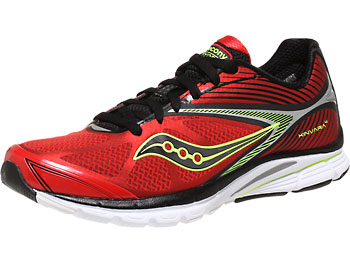

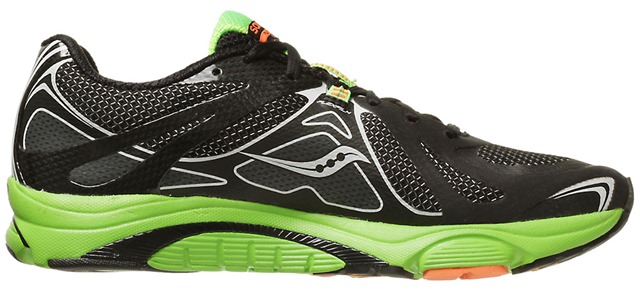
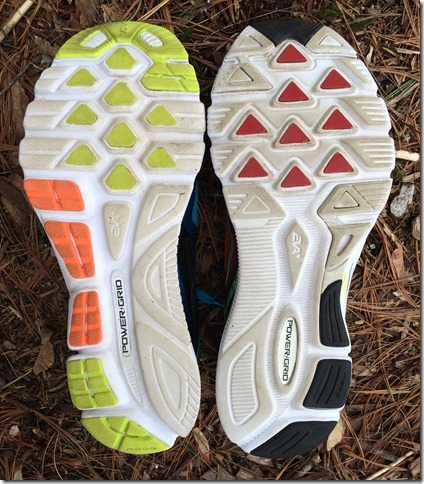















I agree completely, Peter. The Kinvara 7 is a continuum of the line but the midsole is definitely flat and doesn’t provide the same soft and responsive feel of the K5 & K6. I have to admit I’m disappointed with the shoe as the K6 was my main trainer but I’m hopeful that Saucony can dial it in like NB did with Fresh Foam. Like you, I’ve been reaching for the Zante 2 wayyyy more than the Kinvara 7.
The Zante 2 is pretty near perfect, just ran 8 in them this morning, the only thing I’d change is to tone down the arch a bit, I get a bit of pressure there, but otherwise a great distance shoe. Which Runner’s Alley do you work at? I haven’t been into the Concord store in awhile, teaching has absorbed all of my time this past year :)
I have not found a shoe as perfect a fit for me since Kinvara 5. Both Kinvara 6 and 7 were too narrow for my wide feet. When I tried on the 7, the sides of my feet seem to go beyond the width of the shoe.
It’s weird, I’ve seen this said in other reviews about the K7, but my pair seem really wide up front, and visibly appear wider when looking at them next to the K6. The sole also appears to be a bit broader across the forefoot when holding them next to each other, and you can kind of see it in the photos. I wondered if maybe I was sent a wide size as a mistake, but doesn’t appear to be this based on the tag in the shoe. Strange…
Maybe I’ll try to go up half a size and see what happens.
The forefoot of the 7 is much wider than the previous version. As for the upper, i prefer less overlays and more breathability.
Lots of interesting points! The different opinions about the Kinvara 7 fit is indeed weird, it´s like the mystery how socks disappear in the washing machine ;-). For me the K7 fits true to size ( i rarely go a half size up, unless the shoe runs short which is not the case with the Kinvara 7) and the forefoot is really roomy for Kinvara conditions, would also say that it has at least a medium width. Another thing is the Zante v2 which now belongs to the most sluggish shoes i have ever run in. The sole feels really dead to me. In my perception there is literally no energy return/efficiency or springiness, the FreshFoam just feels soft and very flat. New Balance and their foams can be really strange as Revlite feels very different across various models. All in all Revlite itself is not a very snappy/responsive foam for me, although i really liked shoes like the 1400 or the Vazee Pace (which were better at the responsiveness scale).
Feel is such an individual thing, isn’t it. I love the RevLite in the 1400, but hated it in the 1500 and 1600. Zante is soft, but for my stride it works really well, but I have a pretty stiff stride so softer shoes tend to work for me.
Completely agree with the feel. But it looks like there are also a lot of individual biomechanical and neuromuscular aspects that play into the equation of the soft or firm spectrum, about what seems to work for an individual person – fascinating stuff, although i don´t have any expert ideas. Anyway, i´d love to see New Balance bringing up something better than Revlite.
Agree too. Looking from ground contact time (GCT) stand point, it makes sense (to me) that faster GCT benefits (energy return) more from hard midsoles, while slower GCT benefits more from soft midsoles.
Some individuals might have fast GCT even at slow paces, and I would imagine that those individuals might have a preference for harder midsoles and a tendency to dislike softer midsoles.
(warning: those are conjectures of mine, not scientifically supported)
Another factor to consider is leg stiffness – eg how much the leg joints bend to absorb force. I have a pretty stiff limb, so I think I benefit from a softer midsole to take up some of the cushioning. A stiff limb plus a hard midsole might make for reduced GCT, but could result in a jarring ride. Just conjecture by me here as well :)
Seems like we have forgotten what kind of shoe Kinvara was, when it was launched. An “elemental” model, light and flexible, not much padding on the upper, with snappy, responsive cushioning. Since V5, it has become a traditional trainer with 4mm drop, that’s it. Softer, with bulkier feeling, despite the low weight.
I agree 100% that Zante is the Kinvara-killer!
Thanks for the review, Peter!
Great review.
I’ve worn from K4, K5 and now K7. K4s were great, but K5 gave me blacktoenails, and found the right fit tighter than the left.
K7 fixed all that, better fit but find some tearing of the upper around the small toes.
Keep up the great reviews.
Thanks Steve!
Thanks for the great review, Peter. I just got my new pair of women’s Kinvara 7s (royal blue) a few days ago and already love them. I was doing a lot of climbing/hiking in my beloved Saucony Peregrine 4s, but wanted to get back into power/speed walking and needed a more suitable shoe. I knew I wanted a low drop, flex, wide toe-box, and slight cushioning, but what to get? I tried the New Balance 1080v6, but that “fresh foam” is so heavy and chunky and kind of dead. I tried out the Kinvara 5 and 6, but the 7 is the clear winner for me. That EverRun is not a gimmick, but a real advancement. I still enjoy their PowerGrid in other shoes, but this new tech is sweet. And on a visual note, whomever is choosing the colors and patterns now…bravo.